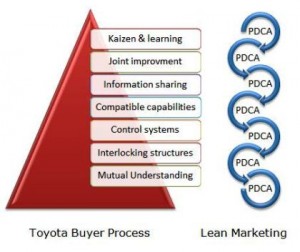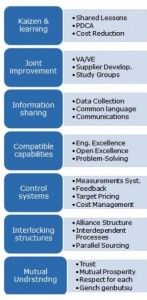This is part of my blog series on using the principles of Demand Drive MRP and its five primary components. This particular blog focuses around Buffer Profiles and Level Determination or in the marketing sense, profiling the customer by your knowledge gaps.
Once the strategically replenished positions are determined, the target levels of those
buffers have to be set initially based on several factors. Different materials and parts
behave differently but many also behave nearly the same. Demand-driven MRP groups
parts and materials chosen for strategic replenishment and that behave similarly into
buffer profiles. Buffer profiles take into account important factors, including lead time
(relative to the environment), variability (demand or supply), whether the part is made
or bought or distributed, and whether significant order multiples are involved. These
buffer profiles are made up of zones that produce a unique buffer picture for each part as
their respective individual part traits are applied to the group traits.
The above is from the Orlicky’s Material Requirements Planning 3/E. written by my recent podcast (Is Orlicky’s MRP relevant today? Think DDMRP) guests Carol Ptak and Chad Smith of the Demand Driven Institute.
I think it may be interesting to group customers not by traditional segments but by the level of knowledge that we have of each other (customer and supplier). If we were to view the stages such as described in the blog post, The 7 step Lean Process of Marketing to Toyota we would see a natural progression through the stages of the supplier – customer engagement. This serves as a good outline for the knowledge that we gain in participation with our customer. 
This type of segmentation leads to better results than a traditional buying cycle. It may seem that many of us are already doing this. If your product groups are actually defined by customer markets and your customer defined by the knowledge gap as distinguished by a method such as the Toyota supplier relationship hierarchy you are halfway there. The first question after that, you must ask yourself when looking at the levels within those cycles is the amount of people or organizations that your company can maintained in that particular cycle. At what amount does it become it an asset or a liability? It is very similar to carry the right inventory. Too little and you miss orders and too much you have resources tied up. Your buffer zone or Work in process(WIP) between these two points is an asset.
Sounds somewhat nonsensical, but this is where we can take many of the Lean Marketing principles and scale them to a larger organization. We are not going to be able to take each individual customer and mirror their decision making paths, it would simply be overwhelming. Instead, we must review the first step in our Demand Driven Marketing Resource Plan, Strategic Position: Positioning your organization to learn from your customers and determine where we have the most customer knowledge or as I like to term it where we have the ability to play in our customers’ playground. Defining this market area allows us to market much more effectively and systematically.
There are four factors that are considered in traditional DDMRP:
- Item Type
- Variability
- Lead Time
- Significant Minimum Order Quantity
They are worth mentioning here as they correspond very closely to a DDMRP marketing system. In DDMRP the item types are designated by purchased, manufactured or distributed. Variability is designated by supply or demand component with further classification of high, medium and low. In the marketing sense we typically group customers similar through the buying channels, but why? What about grouping them through the knowledge hierarchy? Further defining them in the individual cycles that make up the knowledge hierarchy? The reasons are:
- The level of support is readily defined within these cycles.
- Variability is definable by rate of touch points.
- Lead Time is a function of their decision making process..
- Minimum order quantities would relate to size of company.
 The example for this reasoning can be found again in the 7 Step Toyota Suppler model. The 3rd level, Control systems in the hierarchy can be used as an example. Striving to improve the measurement systems, feedback, target pricing areas and cost management structure between vendor and customer are very tangible and smart goals with defined outcomes. It is not a task that is easy but it is readily definable and as a result a method that continuous improvement can be applied.
The example for this reasoning can be found again in the 7 Step Toyota Suppler model. The 3rd level, Control systems in the hierarchy can be used as an example. Striving to improve the measurement systems, feedback, target pricing areas and cost management structure between vendor and customer are very tangible and smart goals with defined outcomes. It is not a task that is easy but it is readily definable and as a result a method that continuous improvement can be applied.
The questions really is can a customer profile be readily applied that is not so general in nature that everyone fit sit or so singular in nature that each company has a separate profile. If we view just that cycle we can identify the support required, the customer decision process for each task and the size of the company we are working with.
What may be needed is to define the variability of these individual companies? Profiling them based on variability or high, medium and low touch companies creates an opportunity to judge the level of support and frequency required. Your higher touch companies will more than likely have a shorter sales cycle. This may be accomplished by condensing the decision making process or eliminating several steps. Going back to the Toyota example, a high touch company may disregard vendor measurement systems and require little feedback. They may be only interesting in target pricing. If you claim that a customer wants to be high touch but have the entire spectrum of services, you will probably find out that may not be a customer you would want anyway.
It is somewhat beyond this blog post to demonstrate calculating the buffer levels but sizing of the buffer levels for each individual component and cycle is possible. The advantage in doing this is that you start managing sales and marketing by demand. You “sense and adapt” to market changes and penetration levels. It is a continuous deployment of a SWOT analysis on a micro and macro level.
Profiling customers based on these four components would allow for a support structure to be developed and ultimately buffer levels developed. If a buffer level is developed, you start managing resources and adjusting capacity much earlier in the sales and marketing cycle. This will result in better use of capital, people and a saving in time for your customers where it is needed most.
Related Information:
The Supplier Partnering Hierarchy of Toyota is from the The Toyota Way Fieldbook
Positioning your organization to learn from your customers
What Sales and Marketing can learn from Demand Driven Manufacturing
Is Orlicky’s MRP relevant today? Think DDMRP
Marketing with PDCA Book Overview

Comments are closed.